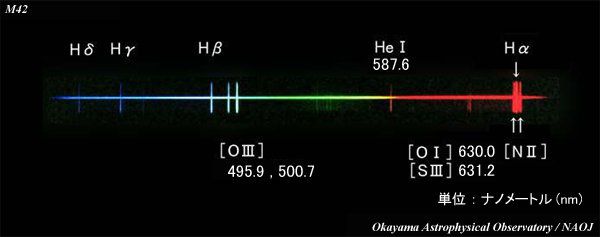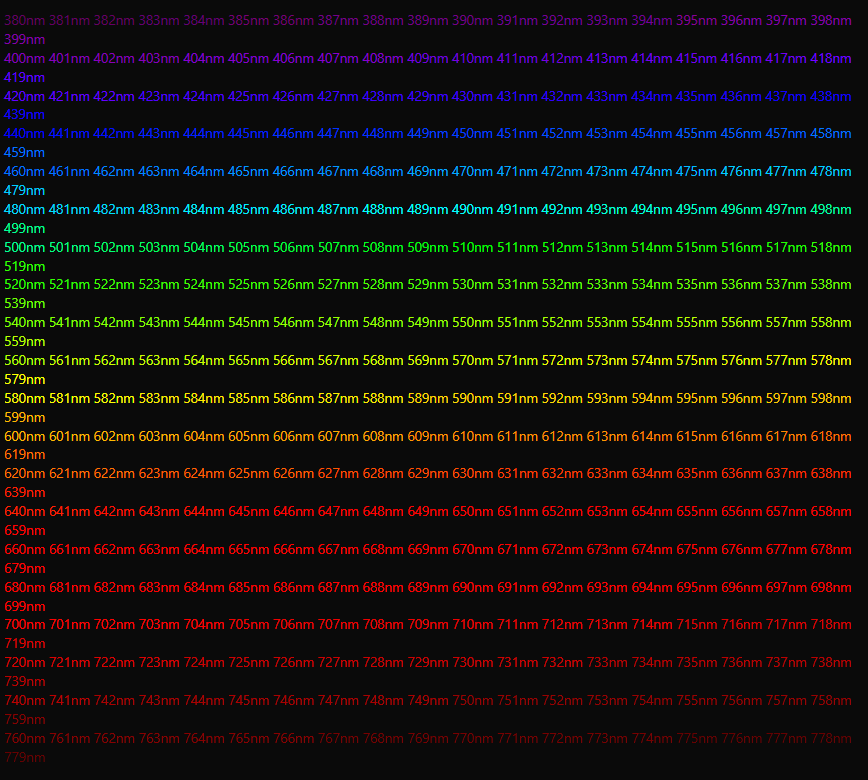When imaging a 'pure' OIII target (so no Hubble palettes etc, but for example Planetary or HO nebula), what is the 'real' colour of the OIII signal? The OIII wavelength is 500.7nm. It is difficult to correlate wavelengths to an RGB image on our screen. But estimates in the mid-range of the spectrum should be fairly accurate. When using tools like this, or this, 500.7nm translates to a hue of 152 and 160 respectively. These are green colours. Often people refer to OIII as cyan or turquoise (according to Pantone very close to cyan, just must less saturated). Their hue is 176-180. Quite a bit more blue. And in practise, it is very tempting to apply NBnormalisation and boost the OIII colours to a nice blue. I certainly do this. Generally my impression is that for these targets, the general trend is to make them a lot more blue than they actually are. What are the thoughts here on this forum? Should we make these targets a bit closer to their actual colour (i.e. make them a bit more green)? Should we stick a bit more to the well known SHO palette and think of OIII as a blue colour? Should we stay somewhat in between those and go for the turquoise? An easy way to think of it is: none of what we image has 'real' colours anyway, so whatever you like most is the way to go.... But until a few days ago I was under the impression that OIII was turquoise/blue-ish, and it was only until I started playing with hue values in the NBColourMapper script that I realised that OIII is pretty green. Just interested in people's opinions. 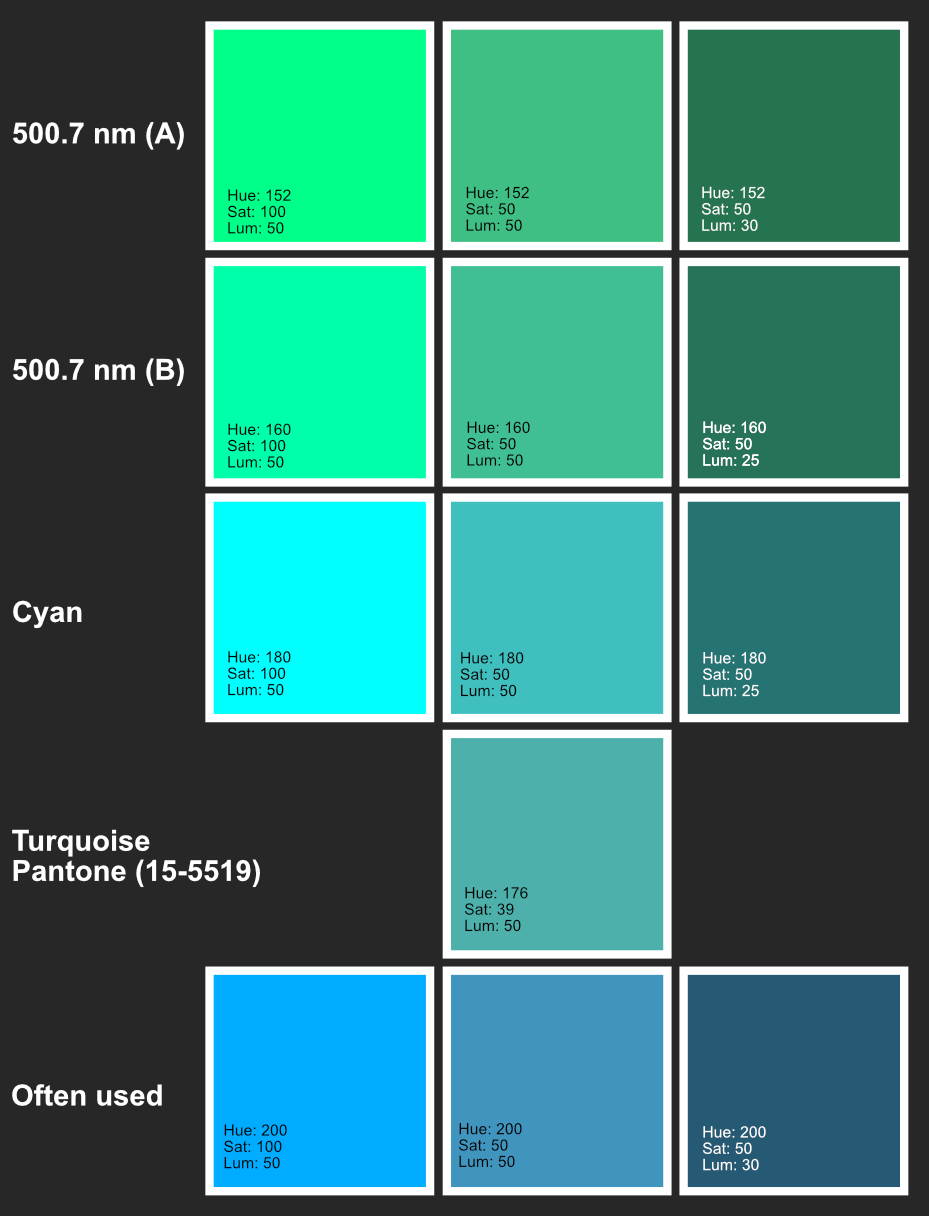 |
You cannot like this item. Reason: "ANONYMOUS".
You cannot remove your like from this item.
Editing a post is only allowed within 24 hours after creating it.
You cannot Like this post because the topic is closed.
Copy the URL below to share a direct link to this post.
This post cannot be edited using the classic forums editor.
To edit this post, please enable the "New forums experience" in your settings.
It's sort of an agua or teal green so if you want totally realistic colors, that's what it should be, no blue at all. At least in isolation. When it mixes with the red of Ha it tends to wash out the red and give a more neutral cream color. That's been my experience shooting dual band Ha-OIII.
|
You cannot like this item. Reason: "ANONYMOUS".
You cannot remove your like from this item.
Editing a post is only allowed within 24 hours after creating it.
You cannot Like this post because the topic is closed.
Copy the URL below to share a direct link to this post.
This post cannot be edited using the classic forums editor.
To edit this post, please enable the "New forums experience" in your settings.
Here's a broadband image I produced of Witches Broom from a couple years ago. I think it should properly answer your question, since Veil is rich in Oiii structure. Colors are properly calibrated. https://www.astrobin.com/3zmrlq/B/?nc=&nce=
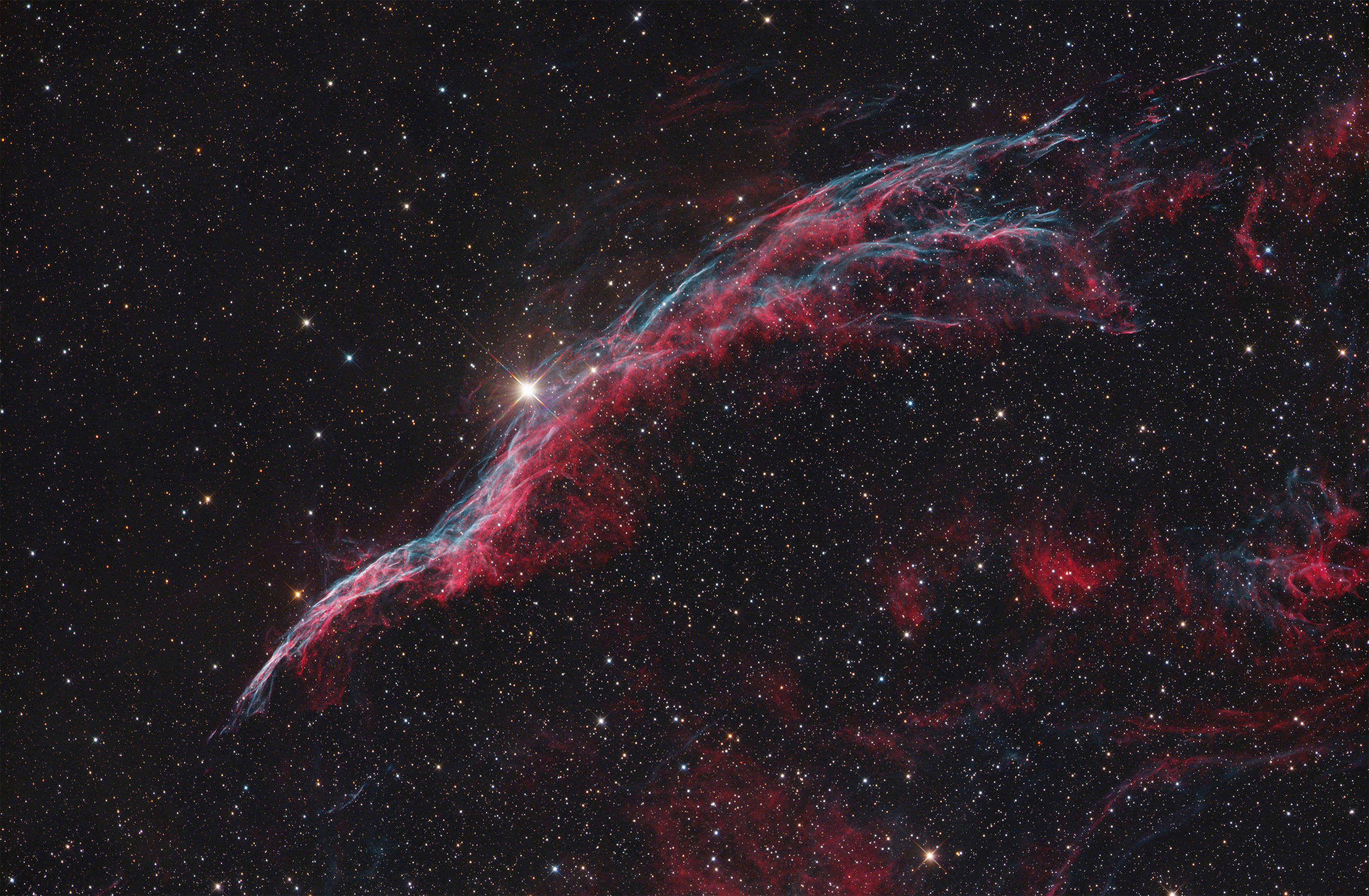 |
You cannot like this item. Reason: "ANONYMOUS".
You cannot remove your like from this item.
Editing a post is only allowed within 24 hours after creating it.
You cannot Like this post because the topic is closed.
Copy the URL below to share a direct link to this post.
This post cannot be edited using the classic forums editor.
To edit this post, please enable the "New forums experience" in your settings.
i quite disagree , in fact o3 is not blue but green . The forum initiator is right .
|
You cannot like this item. Reason: "ANONYMOUS".
You cannot remove your like from this item.
Editing a post is only allowed within 24 hours after creating it.
You cannot Like this post because the topic is closed.
Copy the URL below to share a direct link to this post.
This post cannot be edited using the classic forums editor.
To edit this post, please enable the "New forums experience" in your settings.
You cannot like this item. Reason: "ANONYMOUS".
You cannot remove your like from this item.
Editing a post is only allowed within 24 hours after creating it.
You cannot Like this post because the topic is closed.
Copy the URL below to share a direct link to this post.
This post cannot be edited using the classic forums editor.
To edit this post, please enable the "New forums experience" in your settings.
Willem Jan Drijfhout:
But until a few days ago I was under the impression that OIII was turquoise/blue-ish, and it was only until I started playing with hue values in the NBColourMapper script that I realised that OIII is pretty green. Recently I took a 2.8nm [O III] filter and looked towards it to some diffuse but not too dim sunlight. They color I observed was pretty much towards green. Most of the times I use SCNR, the setting is from 50-80%. Esthetically I prefer cyan/blue.
|
You cannot like this item. Reason: "ANONYMOUS".
You cannot remove your like from this item.
Editing a post is only allowed within 24 hours after creating it.
You cannot Like this post because the topic is closed.
Copy the URL below to share a direct link to this post.
This post cannot be edited using the classic forums editor.
To edit this post, please enable the "New forums experience" in your settings.
I think the confusion comes from the fact that although there is a lot of green in O3, many folks (including me) find too much green in astroimages to be unesthetic so it is not uncommon to increase the blue and/or decrease the green when incorporating O3 into images. Therefore many images may not be exact true color in that band. It does depend on the object and the imager's intent to a large degree so looking at other's images may not result in scientifically accurate colors. But then it almost never does!  |
You cannot like this item. Reason: "ANONYMOUS".
You cannot remove your like from this item.
Editing a post is only allowed within 24 hours after creating it.
You cannot Like this post because the topic is closed.
Copy the URL below to share a direct link to this post.
This post cannot be edited using the classic forums editor.
To edit this post, please enable the "New forums experience" in your settings.
in fact i would recommande to do not use SCNR anymore, now that we have spectrophotometric color calibration we do not need that anymore and we can easily retrieve the correct colors.
|
You cannot like this item. Reason: "ANONYMOUS".
You cannot remove your like from this item.
Editing a post is only allowed within 24 hours after creating it.
You cannot Like this post because the topic is closed.
Copy the URL below to share a direct link to this post.
This post cannot be edited using the classic forums editor.
To edit this post, please enable the "New forums experience" in your settings.
I tend to agree with @Bill McLaughlin on this and like Bill and probably many others tend to move the OIII channel toward the more bluish side but not “all” blue. As others stated it depends on the object and certainly the person processing the image to what their eye likes.
|
You cannot like this item. Reason: "ANONYMOUS".
You cannot remove your like from this item.
Editing a post is only allowed within 24 hours after creating it.
You cannot Like this post because the topic is closed.
Copy the URL below to share a direct link to this post.
This post cannot be edited using the classic forums editor.
To edit this post, please enable the "New forums experience" in your settings.
Shine a white light through a OIII filter, there's your answer.. Generally, the emission is teal (bluish-green) and many nebulae show green in natural color…
|
You cannot like this item. Reason: "ANONYMOUS".
You cannot remove your like from this item.
Editing a post is only allowed within 24 hours after creating it.
You cannot Like this post because the topic is closed.
Copy the URL below to share a direct link to this post.
This post cannot be edited using the classic forums editor.
To edit this post, please enable the "New forums experience" in your settings.
Shine a white light through a OIII filter, there's your answer.. Generally, the emission is teal (bluish-green) and many nebulae show green in natural color... EXACTLY what I was going to say. Just look through it at a white light source! This whole discussion is the optical equivalent of arguing over how many teeth are in a horse's mouth. John
|
You cannot like this item. Reason: "ANONYMOUS".
You cannot remove your like from this item.
Editing a post is only allowed within 24 hours after creating it.
You cannot Like this post because the topic is closed.
Copy the URL below to share a direct link to this post.
This post cannot be edited using the classic forums editor.
To edit this post, please enable the "New forums experience" in your settings.
Hello all, that is really an interesting question, I also when post-process my astro images, l put a considerable effort in trying to understand and to respect what it should be the "real" color. The spectro-photometry based color calibration (I use PixInsight in my case) is in my opinion a really good starting point to calibrate colors, based upon the GAIA catalogues of a huge ensemble of stars spectra. So it should include the wavelenghts corrispondence as you mentioned. Than the color "as appeared" can change according to luminosity and saturation adjustments, but not its base hue. The spectro-photometry based calibration also use as white reference the average broadbands spectra of an ensemble of galaxies (objects containing a huge ensemble of stars, so statistically representing a good population). Colors can also change if using in acquisition narrow-bands filters, and their response curves can be also used in order to calibrate colors of your optics effectively used in acquisition. I tried to use the L-eNhance response curve during the calibration. I also feel "fear" in having too much green as common concept in general read or shared, but here Western Veil Nebula and Pickering Triangle I tried to overcome the "fear" and let OIII to be more green/aqua as I supposed to be. With SCNR used in high % on green, it was changing in blue/light blue the OIII signal, so I did not use any aggressive SCNR on green, having trust in the previous color calibration step based on GAIA catalogues. Best regards and clear skies! Davide.
|
You cannot like this item. Reason: "ANONYMOUS".
You cannot remove your like from this item.
Editing a post is only allowed within 24 hours after creating it.
You cannot Like this post because the topic is closed.
Copy the URL below to share a direct link to this post.
This post cannot be edited using the classic forums editor.
To edit this post, please enable the "New forums experience" in your settings.
It's blue on picture cause of Hubble palette. That why every body try to make it blue (more pleasant to the eye to IMHO) and close to what we saw during the Last 30 years.
But that false color (same for SII that is not orange/gold) OP is good on the color. But as narrowband is false color you can finally choose what you want.
Try it with OIII as magenta for example.
|
You cannot like this item. Reason: "ANONYMOUS".
You cannot remove your like from this item.
Editing a post is only allowed within 24 hours after creating it.
You cannot Like this post because the topic is closed.
Copy the URL below to share a direct link to this post.
This post cannot be edited using the classic forums editor.
To edit this post, please enable the "New forums experience" in your settings.
I agree with the forum initiator. Further, I think that a lot of what we all do in astrophotography is driven by an unwritten concensus that is not really the same thing as being 'correct' in any scientific sense. Most OOH images probably have the O3 looking bluer than it is really for aesthetic reasons. Probably also there is a general tendency to greatly amp up the (anyway false colour) SII and OIII signals relative to the HA for reasons of visual balance and discrimination - although for many objects a more quantitatively honest representation would have HA so far dominant that the other contributions would be mainly swamped. All fine – although sometimes I think it would be good to have a kind of standard process/ recipe - that could be applied to facilitate more quantitative comparisons between different objects (for those interested in such stuff)?
|
You cannot like this item. Reason: "ANONYMOUS".
You cannot remove your like from this item.
Editing a post is only allowed within 24 hours after creating it.
You cannot Like this post because the topic is closed.
Copy the URL below to share a direct link to this post.
This post cannot be edited using the classic forums editor.
To edit this post, please enable the "New forums experience" in your settings.
Generally, OIII is green. There is a second OIII line which is slightly bluer, but it’s still quite green. If you just image OIII with an NB filter, it should look green if you care about real color.
That being said, not everyone images pure OIII. If your final picture contains a mixture of filters, then its color can be anywhere between green and cyan, especially when broadband filters are involved. The reason is that both OIII lines are in the middle of G and B filters. Depending on the BB filters you use, OIII can appear differently. BB filters used in astrophotography are not designed to faithfully reproduce the color seen by human eyes. Even Bayer array filters found on digital cameras, which are supposed to give colors close to that from human vision, can give different OIII colors. So from this point of view, I don’t think there is a standard color.
|
You cannot like this item. Reason: "ANONYMOUS".
You cannot remove your like from this item.
Editing a post is only allowed within 24 hours after creating it.
You cannot Like this post because the topic is closed.
Copy the URL below to share a direct link to this post.
This post cannot be edited using the classic forums editor.
To edit this post, please enable the "New forums experience" in your settings.
Maybe it is better to say that the color of OIII emission is exactly that of its frequency in the spectrum. It's the photographer's presentation of it that varies.
|
You cannot like this item. Reason: "ANONYMOUS".
You cannot remove your like from this item.
Editing a post is only allowed within 24 hours after creating it.
You cannot Like this post because the topic is closed.
Copy the URL below to share a direct link to this post.
This post cannot be edited using the classic forums editor.
To edit this post, please enable the "New forums experience" in your settings.
Agree with the two posts that state "it is what it is". However, the other two posts that refer to broadband Veil images may just highlight a complexity to our perception of color. In isolation, a single color panel may appear to be very different colors when presented within a background of another color. And when placing a true representation of OIII next to the very deep reds of HII, such as within these Veil images will certainly push our perception of the OIII to look bluer than it really is. Such perception color shifts are really common and occur all the time in vision. What would be better proof would be to clip the OIII sections from these broadband images and to align them with a spectral chart to find out what they most closely approach on the spectrum.
One such example in visual astronomy is the the wonderful and colorfully contrasting double star Albireo. Clearly when viewed, one sees a distinctly blue star close by a red (or reddish) star. By standards of star color/saturation, if these two were to be viewed as individual stars, most would probably not really feel that either star was particularly saturated in its color and one might even think one or both was essentially white. Certainly the "red" star would be classed more a yellow star.
Other examples of how the human brain messes with our color perception is the many examples you can find on YouTube, etc, that clearly show one's perception can be completely flipped to seeing blue vs. red for the same color depending on background!
So if you want your image to present proper color for OIII, then I suggest that you not rely on SPCC and its attempt at using the GAIA catalog (which in my hands is so often incapable of getting perfectly correct color), you might want to isolate a small part of a color segment that you can be assured includes exclusively only OIII and then with alignment against a color chart, manually correct your image in that channel. I'll bet that it will open a can of worms...
|
You cannot like this item. Reason: "ANONYMOUS".
You cannot remove your like from this item.
Editing a post is only allowed within 24 hours after creating it.
You cannot Like this post because the topic is closed.
Copy the URL below to share a direct link to this post.
This post cannot be edited using the classic forums editor.
To edit this post, please enable the "New forums experience" in your settings.
For. me, this discussion best exemplifies the "Kermit Conundrum" in our hobby.
It's not easy being green.
|
You cannot like this item. Reason: "ANONYMOUS".
You cannot remove your like from this item.
Editing a post is only allowed within 24 hours after creating it.
You cannot Like this post because the topic is closed.
Copy the URL below to share a direct link to this post.
This post cannot be edited using the classic forums editor.
To edit this post, please enable the "New forums experience" in your settings.
The wavelength of each narrowband emitter can mathematically be transformned into sRGB or AdobeRGB tripels. I have compiled a paper regarding this transformation. In this paper, at the end, you can find all (R;G;B) values for every relevant narrowband line. I developed that method becuase for me, there was to much personal taste in each astro image containing narrowband data. False color to maximize contrast between different lines, however, assigns color in a way, such, that you have a maximum of color difference between all involved lines. My paper explaions, how to assign natural and correct colors to the emission lines. http://jupiter.n-t-l.de/knowledge_narrowband.htmCS Markus
|
You cannot like this item. Reason: "ANONYMOUS".
You cannot remove your like from this item.
Editing a post is only allowed within 24 hours after creating it.
You cannot Like this post because the topic is closed.
Copy the URL below to share a direct link to this post.
This post cannot be edited using the classic forums editor.
To edit this post, please enable the "New forums experience" in your settings.
You cannot like this item. Reason: "ANONYMOUS".
You cannot remove your like from this item.
Editing a post is only allowed within 24 hours after creating it.
You cannot Like this post because the topic is closed.
Copy the URL below to share a direct link to this post.
This post cannot be edited using the classic forums editor.
To edit this post, please enable the "New forums experience" in your settings.
Okay, this is what I believe. I'm open to being told I'm wrong...if people are polite.
Photons have wavelength and frequency. Colour is not a fundamental property of a photon; in fact colour is a neurophysiological / neuropsychological construct that comes about when photons hit the three (in most people) types of cone cells in a retina and are converted into electrical signals that are "interpreted" in our optical cortex. This is why people can argue about whether a colour is yellow or green, for example; we're all a bit differently "wired".
I'd say that you should make your Oiii picture in a colour that pleases your eye.
"I take pictures for me. If other people like them then too bad." I was told this by a tutor on a landscape pics course. Can't remember if the quote is word perfect or who said it. It might be a quote/misquote from Jeanloup Sieff. (If it is I don't especially like his pictures, but then that's the point; it doesn't matter to him if I like his art.
I've always thought the point of narrowband is to differentiate the signals of the different emission lines, not make true-colour images, especially when we all see colour differently. When the James Webb telescope people published first images for public view they had to work out a palette to encompass invisible IR emissions, and they came up with a spectacular image of the Tarantula Nebula. They came up with a spectacular image, and didn't discard the IR data because you just cannot see it. Same for radio astronomers ad UV and X-ray imaging; I want some one to show me what's there, even if it is part of the spectrum that's invisible to my eyes.
I realise this is a subject that arouses passion. |Please all be nice about this.
|
You cannot like this item. Reason: "ANONYMOUS".
You cannot remove your like from this item.
Editing a post is only allowed within 24 hours after creating it.
You cannot Like this post because the topic is closed.
Copy the URL below to share a direct link to this post.
This post cannot be edited using the classic forums editor.
To edit this post, please enable the "New forums experience" in your settings.
Oh and by the way, there's lots of technical advice posted in this thread that is really good, and more "right" than "do what you like", just be aware that there isn't a 100% correct method. You certainly can't please all the people all the time on this one. (different retinas :o) ).
|
You cannot like this item. Reason: "ANONYMOUS".
You cannot remove your like from this item.
Editing a post is only allowed within 24 hours after creating it.
You cannot Like this post because the topic is closed.
Copy the URL below to share a direct link to this post.
This post cannot be edited using the classic forums editor.
To edit this post, please enable the "New forums experience" in your settings.
Just another note to the appearance of OIII in broadband images as light blue. (as in the Veil image above)
This is absolutely normal and expected:
The OIII line is detected by the blue and by the green channel in a proportion defined by the transmission of the B and G filters at the wavelength of the OIII line.
The camera does not know anything about the precise wavelength of the radiation … it simply counts photons in the different channels.
The SPCC calibrates against broadband sources (stars) in a way that the ratio of the photons it detects in B and G from the OIII line gives a blue hue. It depends a bit on the transmission curves of the G and B filter.
That is probably the main reason that the OIII line is associated to a blue hue and any false color mapping (SHO, HOO) uses a blue hue for representing OIII.
If you say, well our eye works similarly and sees 500nm as green: not entirely true: the blue sensors in our eye have a sensitivity at 500nm of about 0.15 while the green sensors have a sensitivity of about 0.5, so not equal and 500nm appears pretty green. Astronomik B and G filters e.g. have a transmission of more than 90% at 500nm … both approximately equal … which gives a more bluish hue.
So … yes, if we could really see colors by eye trough a telescope, OIII would be green. But we never do. We always "see" colors through a camera according to the sensitivity/transmission of sensor/filters which translates OIII into a blue hue for our eyes … if we use broadband filters as we usually do.
|
You cannot like this item. Reason: "ANONYMOUS".
You cannot remove your like from this item.
Editing a post is only allowed within 24 hours after creating it.
You cannot Like this post because the topic is closed.
Copy the URL below to share a direct link to this post.
This post cannot be edited using the classic forums editor.
To edit this post, please enable the "New forums experience" in your settings.
So ... yes, if we could really see colors by eye trough a telescope, OIII would be green. But we never do. We always "see" colors through a camera according to the sensitivity/transmission of sensor/filters which translates OIII into a blue hue for our eyes ... if we use broadband filters as we usually do. Well, ... a bit more than a year ago I had the pleasure and privilege of *looking* through the 3.5m telescope at Apache Point with an actual eyepiece - quite an experience! Jupiter was so bright it actually hurt. And M57 and NGC6543 (the Cat's eye nebula) could be clearly seen in color. and they were blue (with a tint of green but blue clearly be dominant). Afterwards we took shots with the iPhone through the eye piece - and got a pretty good representation of the visual impression. Matthias 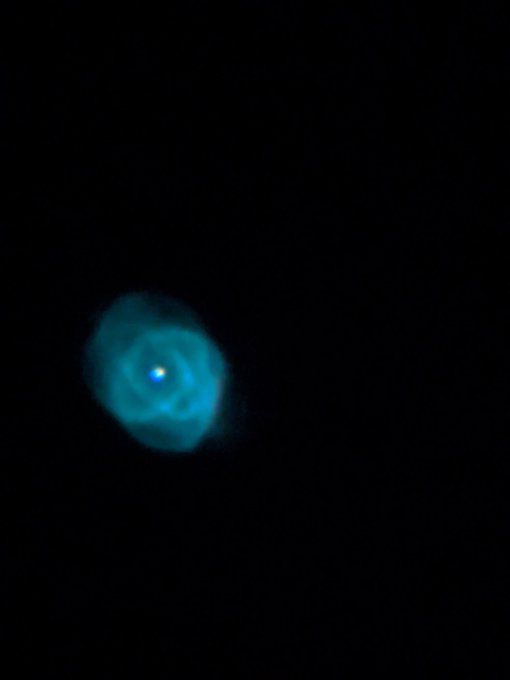 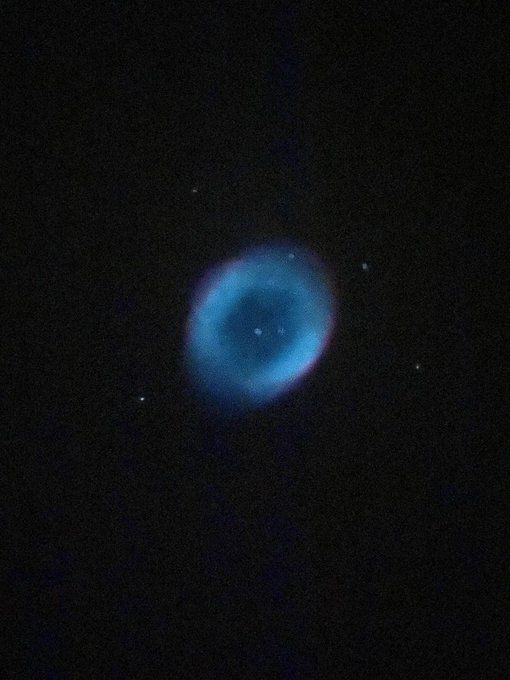 |
You cannot like this item. Reason: "ANONYMOUS".
You cannot remove your like from this item.
Editing a post is only allowed within 24 hours after creating it.
You cannot Like this post because the topic is closed.
Copy the URL below to share a direct link to this post.
This post cannot be edited using the classic forums editor.
To edit this post, please enable the "New forums experience" in your settings.
So ... yes, if we could really see colors by eye trough a telescope, OIII would be green. But we never do. We always "see" colors through a camera according to the sensitivity/transmission of sensor/filters which translates OIII into a blue hue for our eyes ... if we use broadband filters as we usually do.
Well, ... a bit more than a year ago I had the pleasure and privilege of *looking* through the 3.5m telescope at Apache Point with an actual eyepiece - quite an experience! Jupiter was so bright it actually hurt. And M57 and NGC6543 (the Cat's eye nebula) could be clearly seen in color. and they were blue (with a tint of green but blue clearly be dominant). Afterwards we took shots with the iPhone through the eye piece - and got a pretty good representation of the visual impression. Matthias
M57 core is green, not blue, in natural color. In false color, it's up the photographer to do whatever they feel like to represent the wavelength. Even in visual observations one must keep in mind that any red light will shift your night time color vision blue. But who I am to argue if you saw blue or green? Scientifically, we can look at M42 the Great Orion Nebula Trapezium, which is OIII dominate. https://www.aanda.org/articles/aa/abs/2015/10/aa26529-15/aa26529-15.htmlThis is a single, 4 second shot of M42 core taken last night (107mm aperature, 600mm focal length, iso 6400), with a stock 90d dlsr. This highly calibrated light frame shows the natural color fairly accurately. One can even use the narrowband data from MUSE to create a natural color image of M42 core, which is extremely hard to do with standard amateur, narrowband equipment. https://data.aip.de/projects/musescience.html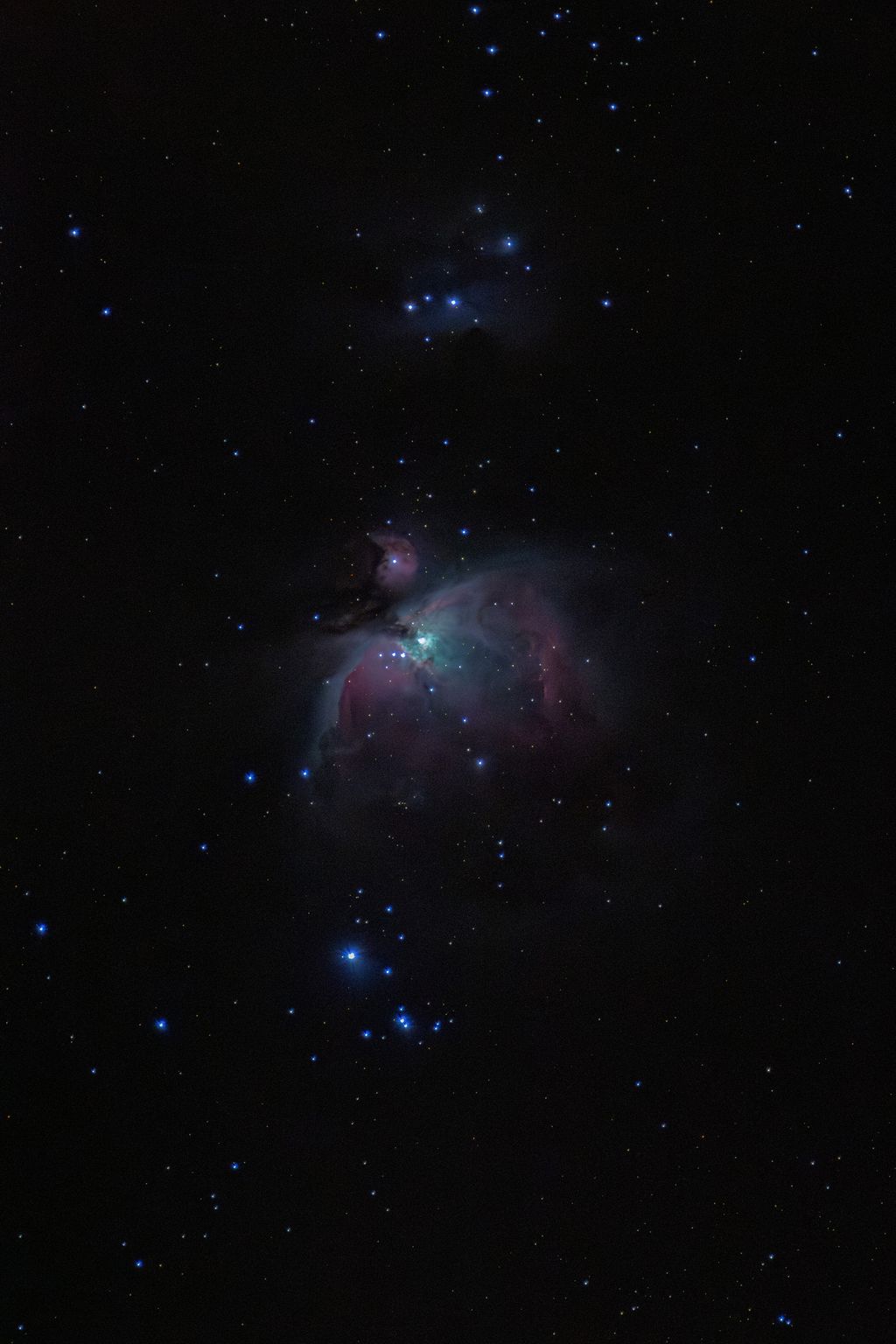 |
You cannot like this item. Reason: "ANONYMOUS".
You cannot remove your like from this item.
Editing a post is only allowed within 24 hours after creating it.
You cannot Like this post because the topic is closed.
Copy the URL below to share a direct link to this post.
This post cannot be edited using the classic forums editor.
To edit this post, please enable the "New forums experience" in your settings.




